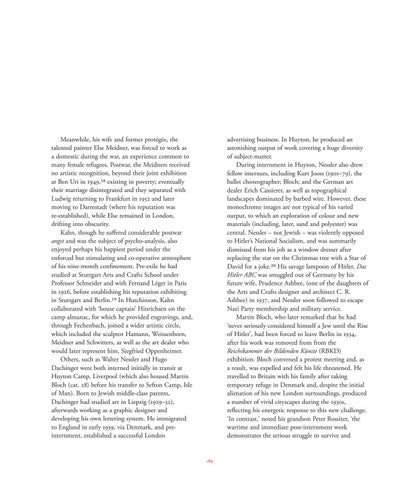Meanwhile, his wife and former protégée, the talented painter Else Meidner, was forced to work as a domestic during the war, an experience common to many female refugees. Postwar, the Meidners received no artistic recognition, beyond their joint exhibition at Ben Uri in 1949, existing in poverty; eventually their marriage disintegrated and they separated with Ludwig returning to Frankfurt in 1952 and later moving to Darmstadt (where his reputation was re-established), while Else remained in London, drifting into obscurity. Kahn, though he suffered considerable postwar angst and was the subject of psycho-analysis, also enjoyed perhaps his happiest period under the enforced but stimulating and co-operative atmosphere of his nine-month confinement. Pre-exile he had studied at Stuttgart Arts and Crafts School under Professor Schneider and with Fernand Léger in Paris in 1926, before establishing his reputation exhibiting in Stuttgart and Berlin. In Hutchinson, Kahn collaborated with ‘house captain’ Hinrichsen on the camp almanac, for which he provided engravings, and, through Fechenbach, joined a wider artistic circle, which included the sculptor Hamann, Weissenborn, Meidner and Schwitters, as well as the art dealer who would later represent him, Siegfried Oppenheimer. Others, such as Walter Nessler and Hugo Dachinger were both interned initially in transit at Huyton Camp, Liverpool (which also housed Martin Bloch (cat. 28) before his transfer to Sefton Camp, Isle of Man). Born to Jewish middle-class parents, Dachinger had studied art in Liepzig (1929–32), afterwards working as a graphic designer and developing his own lettering system. He immigrated to England in early 1939, via Denmark, and preinternment, established a successful London
advertising business. In Huyton, he produced an astonishing output of work covering a huge diversity of subject-matter. During internment in Huyton, Nessler also drew fellow internees, including Kurt Jooss (1901–79), the ballet choreographer; Bloch; and the German art dealer Erich Cassierer, as well as topographical landscapes dominated by barbed wire. However, these monochrome images are not typical of his varied output, to which an exploration of colour and new materials (including, later, sand and polyester) was central. Nessler – not Jewish – was violently opposed to Hitler’s National Socialism, and was summarily dismissed from his job as a window dresser after replacing the star on the Christmas tree with a Star of David for a joke. His savage lampoon of Hitler, Das Hitler ABC was smuggled out of Germany by his future wife, Prudence Ashbee, (one of the daughters of the Arts and Crafts designer and architect C. R. Ashbee) in 1937, and Nessler soon followed to escape Nazi Party membership and military service. Martin Bloch, who later remarked that he had ‘never seriously considered himself a Jew until the Rise of Hitler’, had been forced to leave Berlin in 1934, after his work was removed from from the Reichskammer der Bildenden Künste (RBKD) exhibition. Bloch convened a protest meeting and, as a result, was expelled and felt his life threatened. He travelled to Britain with his family after taking temporary refuge in Denmark and, despite the initial alienation of his new London surroundings, produced a number of vivid cityscapes during the 1930s, reflecting his energetic response to this new challenge. ‘In contrast,’ noted his grandson Peter Rossiter, ‘the wartime and immediate post-internment work demonstrates the serious struggle to survive and
189
